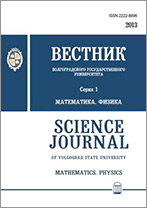|
Mathematics
Convective atmospheric transport of polluting aerosol substance on an arbitrary set of points
E. E. Cheryomukhina, V. G. Mosin
Samara State University of Architecture and Construction
Abstract:
In this article we solve the stationary boundary problem of convective transport of polluting aerosol substance.The task conditions that some weather stations measure wind speed and direction at certain moment of time. According to our theory weather stations are the points at plane and weather information is the set of airflow two-dimensional vectors. The stations' convex hull is the region of study. We suppose that polluting matter density is constant on every linear link of convex hull and it's time-independent. We also suppose that polluting aerosol substance is not diffusing, it doesn't react with the environment or precipitate. Based on these data and hypothesis we have to calculate the polluting matter density in any inside point of the convex hull.
At first, we solve the task in the simplest situation. We consider unit simplex and get explicit formulas for volumes of airflow that goes through simplex sides. If the volume is positive, the flow is incoming (if the volume is negative, the flow is outgoing). We expand the two-dimensional vector field to a three-dimensional vector field and assume that the vertical component of the three dimensional field has a zero density pollutant. We calculate the density of the pollutant inside the simplex based on the ratio of the incoming flows.
After this we take a look at a more complex situation. We take an arbitrary triangle, and transform it into a single simplex using a special affine transformation. This way, we calculate the density of the pollutant inside of the triangle using the formulas that we got previously.
And now we take a more general situation. If the number of points is more that three, we triangulate the set of points and get a set of triangles. For each triangle we solve the problems as mentioned above, in this way we obtain a set of densities. This set of densities we call a quasi-solution for a stationary boundary problem of convective transfer of pollutant. The quasi-solution is not a continuous function. That is why the quasi-solution can give only a rough estimation of the distribution of the pollutant inside of the research area. We interpolate the quasi-solution and as a result obtain a solution for a stationary boundary problem of convective transport of pollutant as a continuous function of coordinates.
Keywords:
linear interpolation, convection, mass transfer, mathematical modeling, finite elements method.
Citation:
E. E. Cheryomukhina, V. G. Mosin, “Convective atmospheric transport of polluting aerosol substance on an arbitrary set of points”, Vestnik Volgogradskogo gosudarstvennogo universiteta. Seriya 1. Mathematica. Physica, 2016, no. 3(34), 28–40
Linking options:
https://www.mathnet.ru/eng/vvgum108 https://www.mathnet.ru/eng/vvgum/y2016/i3/p28
|

| Statistics & downloads: |
| Abstract page: | 105 | | Full-text PDF : | 51 | | References: | 28 |
|




 Contact us:
Contact us: Terms of Use
Terms of Use
 Registration to the website
Registration to the website Logotypes
Logotypes








 Citation in format
Citation in format 